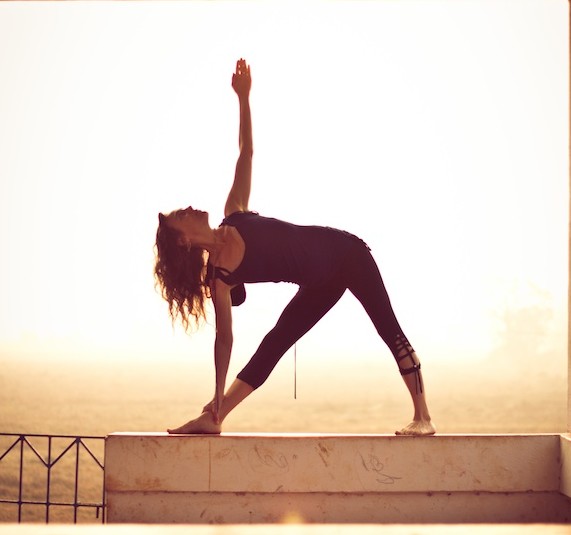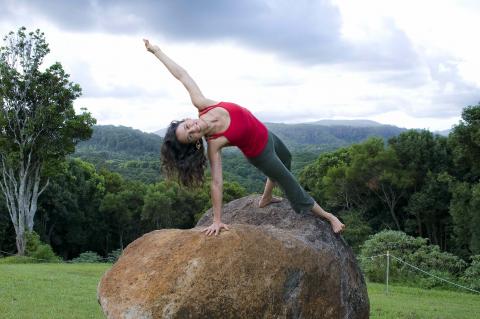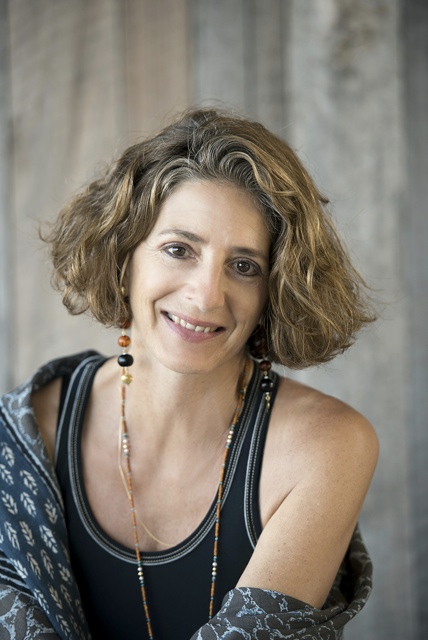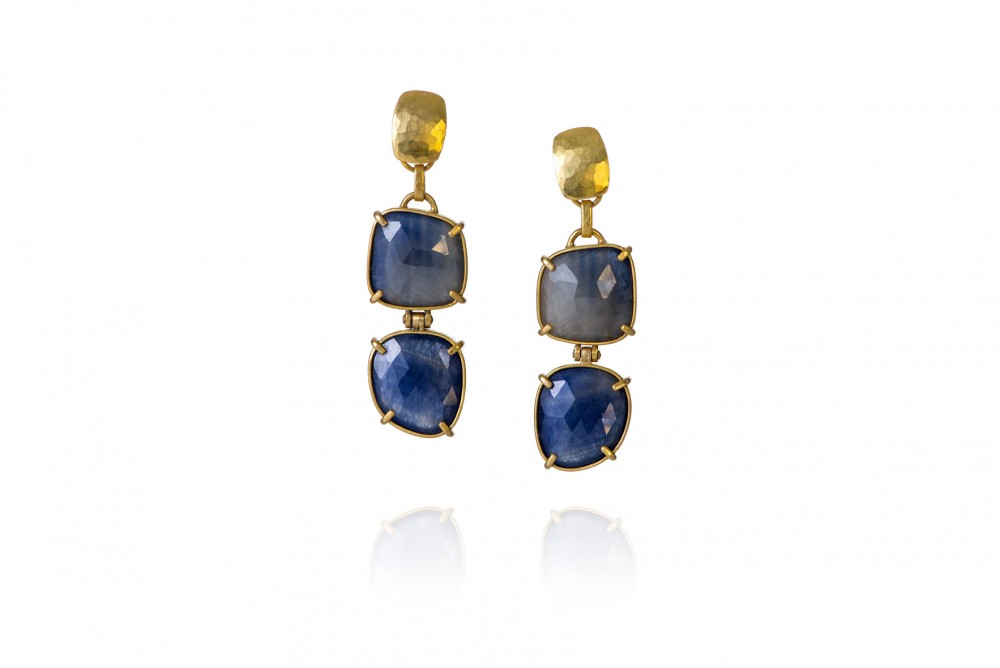The post Rachel Zinman: Learning to live with diabetes appeared first on .
]]>Some people think I live the ideal life. I teach yoga, travel worldwide and have a stable loving partnership. But things aren’t always as they appear.
In 2008 I was diagnosed with diabetes. The diagnosis floored me. How could someone like me – a yoga teacher and a health and wellness advocate get diabetes? And worse why didn’t I recognise the signs?
It’s been a long eight years and I’ve learned many valuable lessons as part of my personal journey back to health. In fact, it’s driven me to pursue my passion for writing. I’ve written a book for people just like me who are longing for simple and effective ways to achieve radiant health through yoga and ayurveda. To get this book out there I’ve set up a crowdfunding campaign. If you’d like to support me in this dream of helping others the site is: https://www.pozi.be/yoga4diabetes
Looking back I’m convinced my health issues started when I was living in New York City during 9/11. I had moved from Byron Bay to New York City to support my-then husband who had dreams of landing a job in radio. We were crazy. We sold everything we had, rented out our four-bedroom mud brick home in Goonengerry, in the hills behind Byron Bay and moved to New York City with absolutely no idea how we would survive financially. Miraculously not long after our arrival things fell into place. I landed a job at one of the biggest and most well known yoga studios not only as a yoga teacher but as one of the co-creators and mentors of their teacher training program.
And then 9/11 happened. It was impossible not to be shocked, disoriented and overwhelmed. I don’t think I ever really recovered emotionally or physically. Six months later I started experiencing a lot of strange physical symptoms. Things like tingling in my fingers and toes, difficulty concentrating, insomnia, a feeling of being overly expanded, frequent urination, hives and skin rashes, racing heartbeat, difficulty digesting and many more things which turned my previously healthy life into a living hell.
I now know that all the various symptoms happened because my immune system had turned in on itself and was attacking the insulin producing cells in my pancreas. Diabetes runs in the family and the stress had triggered the gene. But at the time I was deeply confused and frustrated because no matter what I did, no matter how many doctors I saw, I just couldn’t get better.
When I was finally diagnosed nearly eight years later, my doctor thought I was pre-diabetic. We discussed the possibility that if I changed my diet and increased my intake of various essential nutrients like Vitamin B12 and Iron that there was a chance things would normalise. I took what he said as a sign of hope and assumed whole-heartedly that yoga would come to the rescue. And for a year I succeeded. However, by the end of the year and after more testing my doctor informed me that my high blood sugar was being caused by an autoimmune disease.
I’ve always been rebellious. My dad calls me a crunchy granola girl. It’s why I moved to Byron Bay in the early 80’s and chose to live an eco-friendly, yoga-loving lifestyle instead of a fast-paced city life.
But being rebellious has its drawbacks. I refused to believe that my condition was incurable and set about trying everything from acupuncture, to herbs, homeopathy and ayurveda. The more I searched for answers the more confused I became.
I was told it was a parasite, a weak spleen, too much heat in my liver. Everyone kept telling me that I couldn’t possibly be diabetic, I was too healthy, too fit. But what people think and what’s actually true are two different things. There’s a lot of misinformation out there about diabetes. Most people think of it as a lifestyle disease. They don’t even realise there’s more than one type. And I was one of those people too – there I was living with the disease thinking it was something else. Anything else would have been better than what I actually had.
And then I hit rock bottom. Rock bottom for me was dragging myself up hills to try and get my blood sugar down. I was eating green veggies and eggs and nothing else. I started losing weight, peeing relentlessly and had less and less energy. My blood sugar levels crept up to unsafe levels. Something had to change.
The hardest thing I’ve ever done is face failure. I’m someone who prides myself on being strong and capable. So when I dragged myself to the doctor and admitted I couldn’t do this on my own we both breathed a huge sigh of relief.
At last I was willing to listen. He told me I had LADA diabetes. Latent Autoimmune Diabetes in Adults. It’s called type 1.5. In type 1 the pancreas doesn’t produce enough insulin, in type 2 the body resists the insulin. In type 1.5 there are aspects of both. His recommendation was to start Insulin injections. One shot a day.
When I stood on my yoga mat that evening I couldn’t stop crying. I felt so relieved. Finally I had an answer to why I just couldn’t get well. Insulin, I realised, wasn’t a bad thing – it was going to save my life.
Insulin gave me back my energy and inspired me to get informed. One of the first things I did once I accepted my diagnosis was to go online and join some support groups. To my surprise I discovered a global community – people just like me living with diabetes and thriving.
Once I looked back at the timeline of my illness and understood a bit more about the complexity of the disease I realised that rather than failing me yoga had been my constant companion. Things could have been much worse. My passion for practice and the depth of my understanding had actually kept the disease from progressing faster.
In my 30 years of experience I can absolutely vouch for yoga and its benefits. Yoga works.
Diabetes is a stressful disease, you’re on call 24/7. You have to literally think like a pancreas using medication to mimic what the body does automatically. Just one miscalculation can threaten your life.
With all these challenges in play it’s hard not to fall prey to emotions. That’s where my yoga practice has helped me cope. Every time I stop, drop and breathe I feel better. Every time I stretch and focus my mind on a posture, the worry melts away. Each time I practice a simple meditation I gain perspective.
Reaping the benefits of my practice while living with a chronic condition has inspired me to write a book to share how yoga can be incorporated into a daily diabetes management regime. And what’s in the book isn’t just for people with diabetes, Anyone can benefit from bringing simple yoga practices into their daily life. In fact here are eight things you can do every day to feel your absolute best.
Rachel’s eight-point list
Wake up just before sunrise, sit quietly and take a few moments to feel grateful.
Find a physical practice that inspires you, it could be yoga, walking in nature, swimming in the ocean. Whatever it is just do it!
Take a few moments for reflection and stillness. You don’t need to label it. Just stop for a moment and be.
Eat fresh, wholesome and organic foods.
Express your creativity in a way that nurtures you.
Make time for your friends and reach out for support.
Sleep when you’re tired. Eat when you’re hungry. And laugh and cry when you feel the need.
Explore life’s deeper meaning. Understanding yourself and your relationship with creation is vital to being able to accept whatever comes along.
Rachel Zinman is a senior yoga teacher and teacher trainer with over 30 years experience teaching nationally and internationally. She is currently completing a book on Yoga for Diabetes. If you’d like to preorder a copy or want more info visit https://yogafordiabetesblog.com/yoga-for-diabetes-book/ <https://yogafordiabetesblog.com/yoga-for-diabetes-book/> and her blog https://www.yogafordiabetesblog.com
The post Rachel Zinman: Learning to live with diabetes appeared first on .
]]>The post The landscape of jewellery appeared first on .
]]>It’s obvious, from the moment you begin the drive from the road down towards Lisa Hochhauser’s house, and towards her studio that someone in the family loves gardens. There is a symmetry and grace to the layout and design of everything around me that is quite breath-taking.
So when I arrive at Hochhauser’s studio, where she creates her Lisa Black Jewellery and we start to talk, it comes as no surprise to discover that she is the secret behind the garden.
“I originally trained as a landscape architect,” she says. “When we lived in Sydney I taught at Sydney Uni as a design tutor and worked for numerous big firms over seven or eight years.”
The ‘we’ she refers to is her husband, ex-Sotheby’s director Robert Bleakley, and their three children. They made the move from Sydney to Byron 14 years ago, and it was clear to Hochhauser that she would need a career change.
“I knew from the time we’d been coming up here that landscape was not often a high priority on people’s lists,” she says. “It was either something they didn’t see the value in, or they’d do it themselves. I think it’s less like that now, but when we decided to move I knew I’d have to do something.”
As it turns out that ‘something’ turned out to be an almost inevitable career path. “I didn’t realise this for many years,” she says, “but in some ways my family influences must have been at play in my decision. I’d always loved jewellery and that goes back to my grandmother. She had a small dairy restaurant on the Lower East Side in New York, and that’s where my mother grew up too. When the Depression hit they had the restaurant, so unlike many people they had food. People with no money would go into this restaurant and they would pay for food with their jewellery. I have this memory of playing with all these fabulous pieces and precious stones – and lots of things that were fashionable for that era – marcasite and rhinestones for instance – and I think as far back as that is when I began to develop a love of finding one thing to go with another thing.”
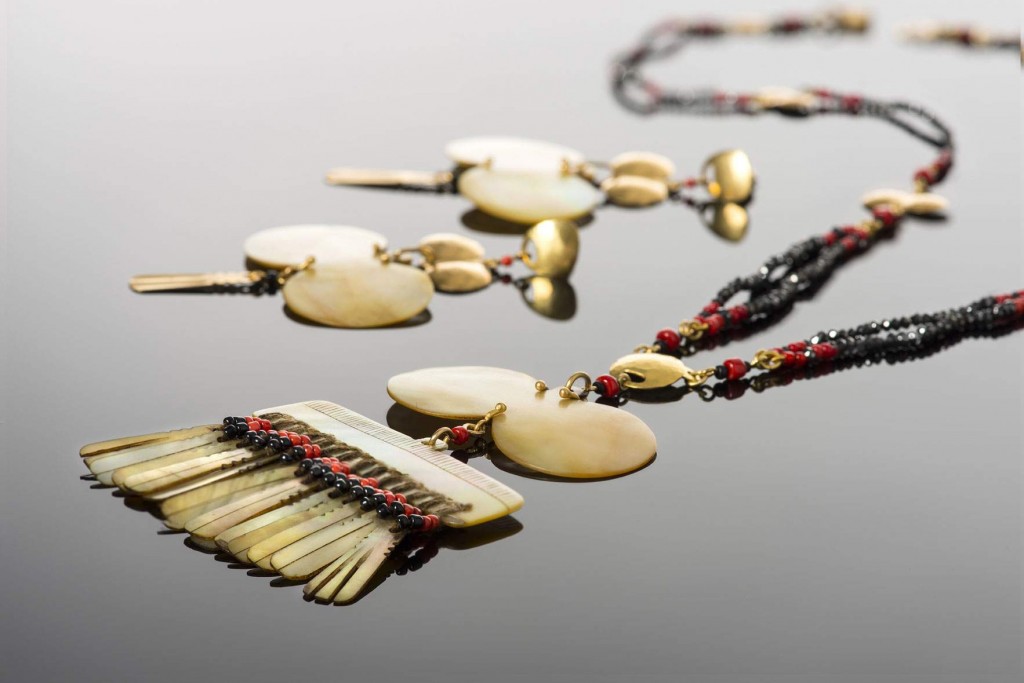
Kalinga butterfly earring with old black sapphire and red glass beads and hand hammered 22kt gold
Kalinga fringe and black diamond necklace
In fact, it’s that notion of pulling something together into a cohesive whole that creates a similarity between landscape and jewellery, despite the obvious difference in the size of the projects, says Hochhauser. “If you think about it there’s many architectural aspects to jewellery-making,” she says. “You need to be able to judge the weight and proportions of what you’re making, how what you’re working with balances. It involves drawing, texture and colour, and those are all things I enjoy.”
Hochhauser’s decision was originally based more on the notion that she would need to have some kind of creative outlet, but it quickly became a profession for her. She carefully searched for people who were like-minded in their quest for perfection, including a Dutch silversmith. “Jann is a fine master craftsman,” she says. “I really wanted to find someone who could do gold work with the same aesthetic sensibility as me, and when I found him the jewellery began to take form.”
Surprisingly perhaps the combination of landscape architect and jeweller in one package is not as unusual as you might think. The legendary landscape architect, author and critic of postmodernism, Charles Jencks has designed jewellery, including a pendant sold to raise funds for Maggie’s, a charity named after his wife who died of cancer. Tasmanian landscape architect Kevin Mullins has moved into jewellery design and Brisbane-based jewellery designer, Kate Phillips is also a landscape artist. Says Hochhauser: “Artist Anish Kapoor has created some beautiful jewellery – Rene Magritte, Dali, the architects Michael Graves and Zaha Hadida – the list goes on…”
These days most of Hochhauser’s time is spent involved in her jewellery design, although she admits to still missing the more major landscaping projects from time to time. However there is one major advantage to being a jeweller. “If you’re a landscape architect finally you’re bound by the client,” she says. “If the client wants an English cottage garden for a modern Australian house perched on a cliff then in the end no matter what you say, you have to give them what they want. But creating my jewellery I have the final say!”
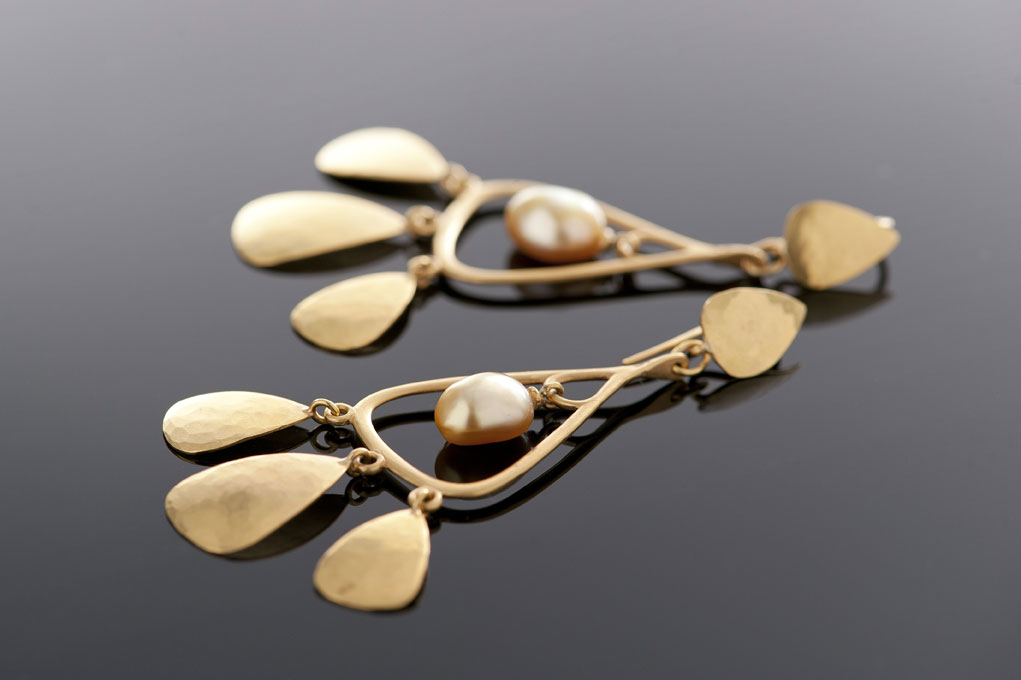
Classic Chandelier with gold droplets: Golden Australian South sea keshi pearl in teardrop frame with hammered 22kt gold
Unlike a lot of jewellers Hochhauser doesn’t work in with the fashion industry, or in seasons. “I’m more like an artist,” she says. “The inspiration comes to me as an artist’s work comes, and it doesn’t necessarily change every season. I have a hoard of old tribal bits and pieces, and I go to jewellery shows around the world, and what tends to happen is that an idea will grab me because of some beads I’ve found. At the moment we’re doing Sapphire Jayne, and I’m really loving working with ‘rough’ jewellery, using uncut diamonds, sapphires and rubies. I love the look and feel of them – they seem much more organic than the more polished pieces.”
Ultimately though, what makes her chosen profession a passion rather than just a job, is matching her pieces with people. “It’s an odd thing to describe, but it’s as if there is someone out there for each piece. I remember I’d made a piece for my sister, and my sister-in-law wanted something similar, but when I’d made it, it wasn’t quite right for her. The piece literally waited for a year or so before I had a show in Sydney and a friend of mine fell in love with it. It had to wait for her – but when she put it on and it was so right for her, it was the most amazing feeling. I literally get goosebumps when that happens.”
In her beautiful studio, complete with kitchen, bedroom and verandah, Hochhauser finds the solitude and quietness she needs to create her pieces – and she houses all her ‘found’ objects in drawers and cupboards. She opens some to show me – rough diamonds, carved shells from PNG, amber, glass mullion – a treasure trove of new and old, pre-loved and love-to-come. There’s an alchemy in her art, and suddenly, it seems, a direct link back to her grandmother’s apartment – an honouring of the people who sold their jewellery to pay for food in this constant creation of jewellery where old and new nestle together to create a future story.
On the day we talk Hochhauser is getting ready to embark on an epic trek to Ahmedabad – and impoverished and remote area of India. The five-day trek through the desert landscape of western Gujurat is meant to gather support for, and increase awareness of, the area. ‘Steps for Schools’ aims to build community as it rebuilds and renovates pre-schools, with a core emphasis on basic education, nutrition, hygiene and love. Having pledged to raise $3,500, at last count she had raised over $4000 for the project – and for her it’s an important way to ‘give back’ to the world.
As I leave the property I see quite clearly the reference points in the landscaping Hochhauser has done around the family home with her singular jewellery design in the natural way everything flows together, with the occasional singularly striking element to attract attention. It occurs to me that in writerly terms if a landscape is a novel, with everything writ large, then a piece of jewellery is like a perfect short story – elegant, precise and perfectly formed. A perfect combination for two lifelong careers, one could say.
Top image: Rose Hinge Earrings, rose cut brown tourmaline triangle with hinged triangle and triangle post, hand hammered 22kt gold.
website: lisablackjewellery.com>
email: [email protected]
To help Lisa Hoch
The post The landscape of jewellery appeared first on .
]]>